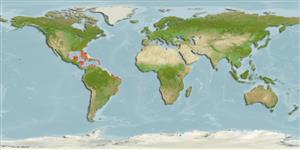>
Anguilliformes (Eels and morays) >
Ophichthidae (Snake eels) > Ophichthinae
Etymology: Callechelys: Greek, kalos, kallos = beautiful + Greek, enchelys, -yos = eel (Ref. 45335); bilinearis: Name from Latin 'bilinearis' meaning two-lined, referring to the stripes along the body; an adjective (Ref. 54133).
Environment: milieu / climate zone / depth range / distribution range
Écologie
marin démersal; profondeur 0 - 22 m (Ref. 27478), usually 1 - 5 m (Ref. 5288). Tropical
Western Atlantic: Bermuda, throughout the West Indies, from islands of Central and South America. Lesser Antilles (Ref. 26938). Southeast Atlantic: St. Helena and Ascension islands.
Taille / Poids / Âge
Maturity: Lm ? range ? - ? cm
Max length : 170 cm TL mâle / non sexé; (Ref. 26938)
Description synthétique
Morphologie | Morphométrie
Large, TL 1.7 m, head and body longer than tail. Pale with 2 dark brown stripes on side and another on outer part of dorsal fin (Ref. 26938).
A sand-dwelling eel. Inhabits open beaches and beaches semi-protected from open ocean (Ref. 5521). Reported to reach 172.4 cm TL (Ref. 27478). Minimum depth from Ref. 005288.
Life cycle and mating behavior
Maturité | Reproduction | Frai | Œufs | Fécondité | Larves
Böhlke, J.E. and C.C.G. Chaplin, 1993. Fishes of the Bahamas and adjacent tropical waters. 2nd edition. University of Texas Press, Austin. (Ref. 5521)
Statut dans la liste rouge de l'IUCN (Ref. 130435)
Menace pour l'homme
Harmless
Utilisations par l'homme
Plus d'informations
Noms communsSynonymesMétabolismePrédateursÉcotoxicologieReproductionMaturitéFraiRassemblement de ponteFéconditéŒufsDéveloppement de l'œuf
Taille/ÂgeCroissanceLongueur-poidsLongueur-longueurFréquences de longueursMorphométrieMorphologieLarvesDynamique des populations larvairesRecrutementAbondanceBRUVS
RéférencesAquacultureProfil d'aquacultureSouchesGénétiqueElectrophoresesHéritabilitéPathologiesTraitementNutrientsMass conversion
CollaborateursImagesStamps, Coins Misc.SonsCiguateraVitesseType de nageSurface branchialeOtolithesCerveauxVision
Outils
Articles particuliers
Télécharger en XML
Sources Internet
Estimates based on models
Preferred temperature (Ref.
123201): 24.7 - 28.1, mean 27.4 °C (based on 710 cells).
Phylogenetic diversity index (Ref.
82804): PD
50 = 0.5000 [Uniqueness, from 0.5 = low to 2.0 = high].
Bayesian length-weight: a=0.00089 (0.00039 - 0.00204), b=3.00 (2.80 - 3.20), in cm total length, based on LWR estimates for this (Sub)family-body shape (Ref.
93245).
Niveau trophique (Ref.
69278): 4.1 ±0.6 se; based on size and trophs of closest relatives
Résilience (Ref.
120179): Faible, temps minimum de doublement de population : 4,5 à 14 années (Preliminary K or Fecundity.).
Fishing Vulnerability (Ref.
59153): Very high vulnerability (90 of 100).
